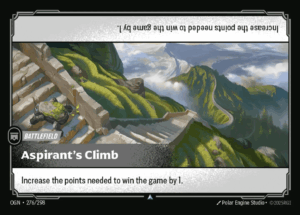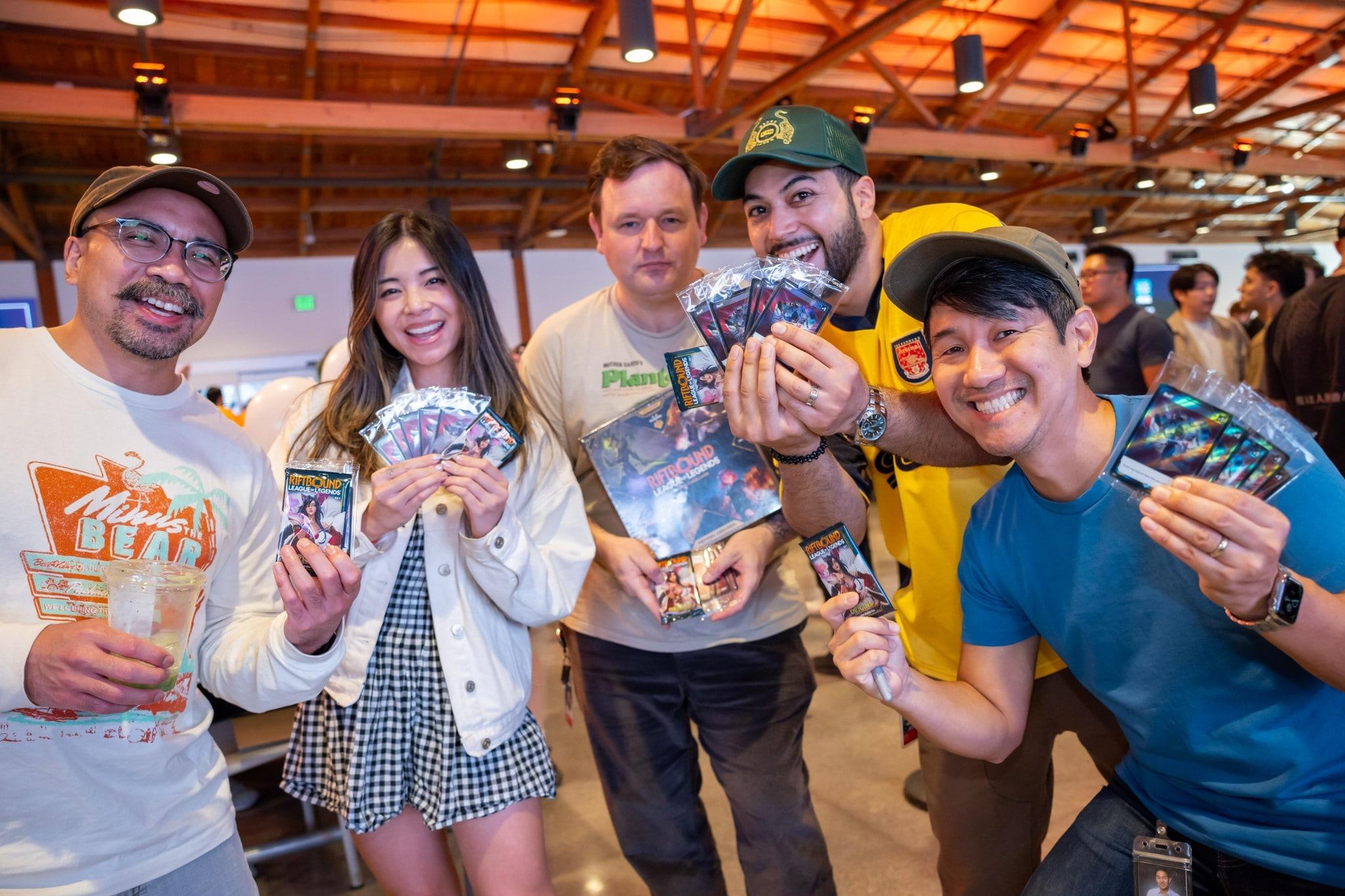Riftbound: Your Complete Beginner’s Guide to the New League of Legends Trading Card Game
It’s here! The newest and much anticipated trading card game set in the world of Runeterra, Riftbound, has officially hit the stores. Riftbound sees its players command Champions, claim battlefields, and channel runes to secure victory.
Whether you’re a League of Legends fan or a newcomer to the world of Runeterra, here’s everything you need to know about how to play Riftbound and what to expect from its release events.
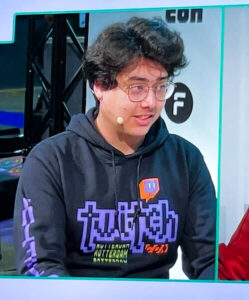
Alex Kivitz
Queueing Up - The Basics of Battle
Riftbound breaks away from the typical “reduce your opponent’s life to zero” formula many trading card games have and offers an interesting spin on how players win the game. In Riftbound, players win the game by capturing and holding battlefields. These battlefields are chosen as part of your deck and we will cover deck building in just a moment.
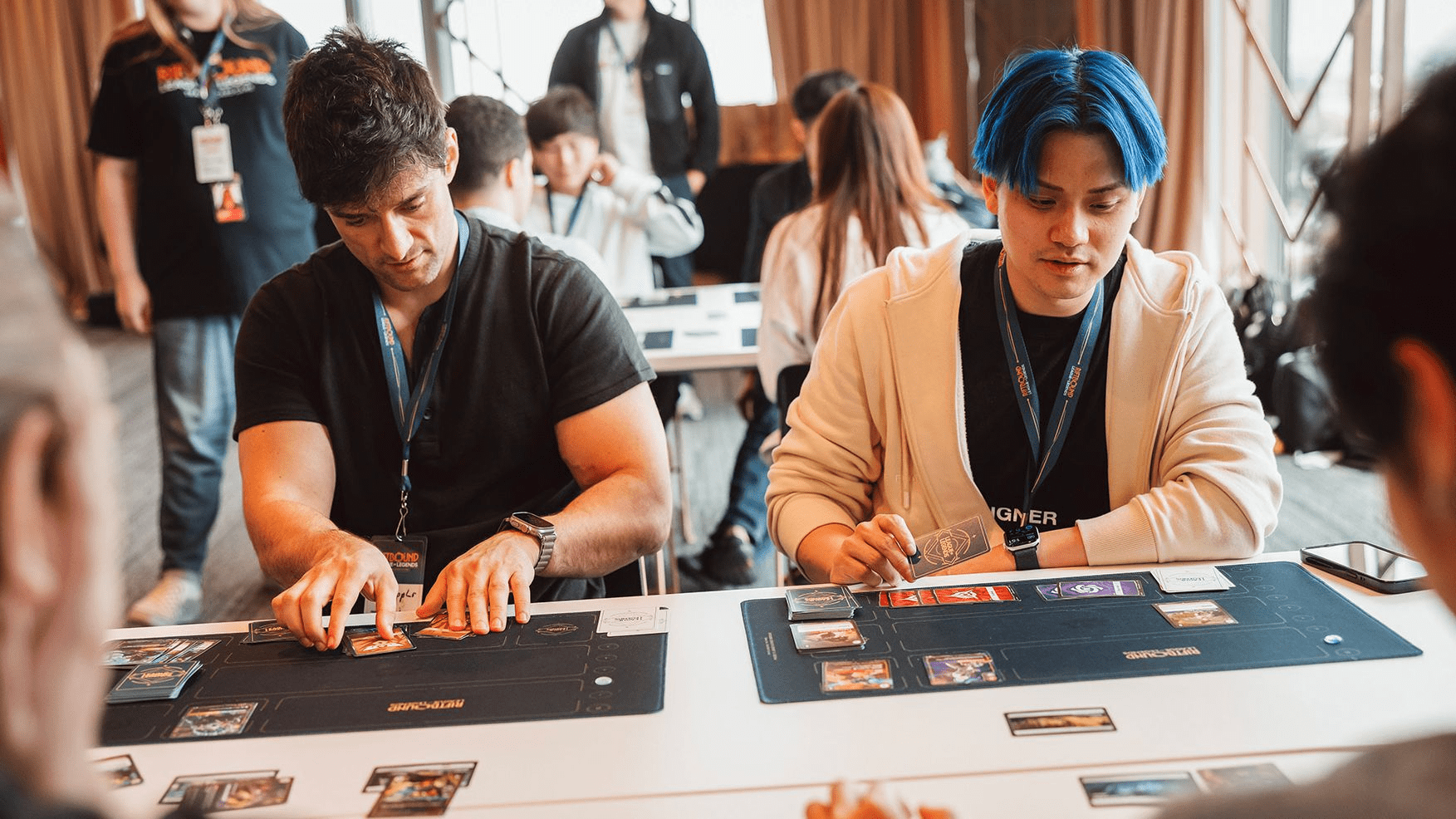
The first time a player captures a battlefield they score a point. Holding onto a battlefield at the start of your turn also scores you a point. You can only score a point from each battlefield once a turn. The first player to score 8 points wins the game!
Notably the 8th point must come from holding a battlefield, or scoring all battlefields in one turn. If you would score your 8th point from conquering, and have not scored at the other battlefield on your turn, you instead draw a card. This system rewards timing, positioning, and long-term planning over brute force.
Choose Your Champion - Building Your Deck
At the heart of every deck is a Champion Legend, your hero and deck leader. This Champion defines your play-style and determines which domains you can include in your deck. Your domains are essentially which cards you are allowed to put into your deck. Lux – Lady of Luminosity, for example, has the Mind and Order domain on her Champion Legend card. This means her deck must only contain cards of the Mind and Order domain, or blue and yellow cards more simply put.
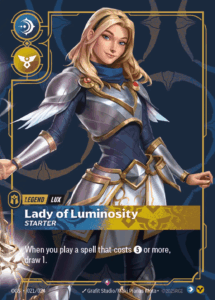
Your deck consists of a few distinct parts. There is the Chosen Legend, as mentioned above, your Main Deck, a Rune Deck, and your battlefield cards. Your main deck is the majority of your cards. In your 40 card main deck, you must have at last one Champion Unit, a unit that matches your Champion Legend.
For Lux – Lady of Luminosity, you can have either Lux – Illuminated or Lux – Crownguard as your Champion Unit. Your Chosen Champion starts the game outside of your deck and may be played whenever you are normally able to play a Unit card. When it is defeated, it goes to the Trash like any other card.
Each card can be in your deck up to 3 times, however, this is only for each uniquely named card. You can have up to 3 Lux – Illuminated and 3 of Lux – Crownguard in your deck at the same time, if you wish.
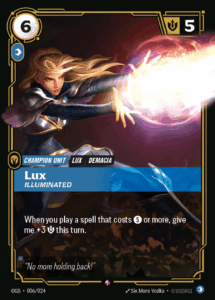
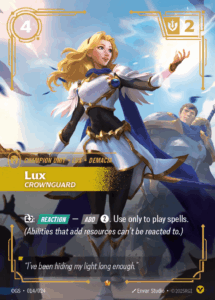
A Summoner’s Rune Deck consists of 12 Rune cards in any ratio you so wish. If you want to go with a standard 6 Order Runes and 6 Mind Runes, you can. You can even go 12 Order Runes if you really want to.
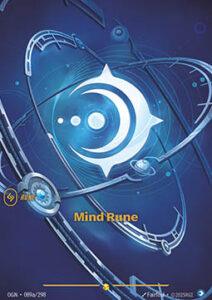

The last part of your setup are your battlefields. These are integral to your overall strategy, how you will approach the game, and most importantly, how you win. As a part of your deck you will have 3 battlefields that you choose to bring with you.
Depending on if you are playing best-of-one or best-of-three, you will use one of these at random or get to choose which battlefield you use at the start of the game. Each player in a one versus one setting will present a battlefield, and this will shape how the game is played, and what modifiers are in effect. Being a pretty good control deck, some potential battlefields Lux will enjoy utilising are probably Aspirant’s Climb, The Grand Plaza, and Vilemaw’s Lair.
So, in summary, what you need to play is:
1 Champion Legend
40 Main Deck Cards
12 Rune Deck Cards
3 Battlefield Cards
Unlocking Runes - Understanding Card Anatomy
Among the Main Deck, there are three key types of cards to understand and learn. These are your Unit cards, Gear cards, and Spell cards. Let’s start off with what is likely the most played card type in many decks, the Unit cards.
Units
Let’s take a look at Darius – Executioner. The first thing you’ll want to look at is the unit’s cost. This can be found in the top left. There are two aspects to a unit’s cost, their Energy Cost and their Power Cost.
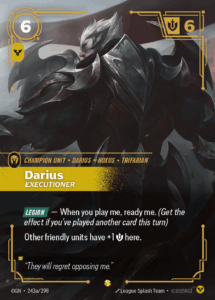
The Energy cost is the number you see in the top left, in Darius’ case, it is 6. This is the number of runes you will have to exhaust to pay the energy cost. Underneath the 6 is a yellow Order symbol. These symbols underneath a card denote a Power Cost. To generate a power, you must recycle a rune of the matching colour. To recycle a rune, you simply return it to the bottom of the Rune Deck; this can be a ready or exhausted rune. Not every unit will have a Power Cost, and some may have multiple symbols.
So, in total, to play Darius – Executioner, you must exhaust 6 runes and return one yellow/order rune to the bottom of your rune deck. Unless stated otherwise, Units enter the battlefield exhausted. Additionally, unless stated otherwise, you may only play units at your base, or a battlefield you control.
Next up is a Unit’s Might. This is much simpler. A Unit’s Might is how much damage it deals and how much damage it can take before it is defeated in combat. This number can be modified and changed as well through card effects. Darius’ Might is 6, and can be found in the top right of the card.
Finally, there are the Unit’s Tags and Effects. Above the Unit’s Name, you can see Darius has the tags of Champion Unit, Darius, Noxus, and Trifarian. Currently, these don’t do anything on their own, but they may be referenced for other card effects. Below his name plate is his text box, which detail special effects the Unit may have.
Gear
Gear is another type of card in Riftbound, and like units, these gear cards stay in play until they are destroyed. However, it is important to note that as of yet, Gear cannot hold or conquer battlefields, and can only exist in base.
If a Gear card is played at a battlefield, it is immediately recalled to the base. Some Gear have abilities that are static and don’t require any actions, while some have costs and must be activated. These costs can have energy as well as power costs, as seen with a card like Baited Hook
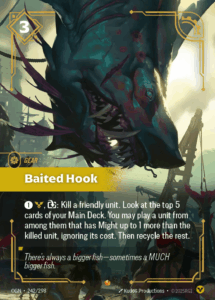
Spells
Unlike units and gear, spell cards are played and have a one-time effect. They are then placed into your Trash Zone. They also have keywords that dictate when you can play them. Some spells are Actions or Reactions, that enable you to play them outside of your turn during specific windows.

Match Found - How to Set Up and Play
Starting a game of Riftbound is quick and easy. Let’s take a look at the zones as shown on a graphic from the Riftbound website. The first thing you do is place your Chosen Legend onto the appropriate zone next to your base area. Then you take your Chosen Champion from your deck and put it next to your Champion Legend. Ideally you place it in such a way that it can’t be confused for being at your base or in play.
Then you take your remaining 39 cards from your deck, shuffle them, and place them underneath your Chosen Champion and Legend. Some players put their trash next to their deck while others put it below, that’s up to you. Underneath your base area is where you put your Runes as you channel them, and to the left is your Rune Deck. Once you’ve shuffled your Main Deck and Rune Deck, you can decide which battlefields you will play on.
In a best-of-one match, each player selects a random battlefield. In best-of-three each player may select their battlefield, however, that battlefield may not be selected for any subsequent game of the match. Finally, you determine which player will be the starting player. Then you can get right into playing Riftbound!
Learning the Controls - How to Play Riftbound
Once you’re all prepped and ready to play, each player draws their opening hand of four cards. If you are unhappy with your starting hand, you may take a single mulligan. In Riftbound, you mulligan by taking up to 2 of your cards and placing them at the bottom of your main deck. Then you draw a card for each card placed at the bottom of your deck. Now that you have your opening hand, let’s get into the turn cycles of Riftbound.
During your turn you have two main sections. You have your start of turn portion of the turn, and your main phase. The start of turn consists of 4 mini-phases where you go about setting up your turn. These mini-phases are remembered using the acronym ABCD.
A – Awaken. This is where you awaken all your runes, units, gear, and your champion legend. Anything you control that is exhausted is now awakened, simply by turning them until they are right side up.
B – Beginning. This is the beginning phase where you check to see if you control your battlefields and score points. Other effects that happen during the beginning phase happen here as well.
C – Channel. Here is where you channel two runes from your rune deck. Simply take the top two cards and flip them face up into your rune zone. If you are the second player, on your very first channel phase you channel an additional rune, going to three runes instead of two.
D – Draw. This is the draw phase where you draw the top card of your deck for turn.
After completing all of these actions, you enter the action phase. Here is where the majority of gameplay happens. You can play cards, move units to battlefields, and activate abilities. There is no set order in which you do these actions and can do them as often as you like as long as you have the resources and ability to perform those game actions. Let’s break down the individual aspects of your action phase.
Playing Cards
This is the most straightforward. Here you simply play your cards from your hand in any order you so wish. Simply declare you are going to play a card, pay its cost, and resolve the effect. If it is a unit, you may play the unit into your base exhausted, or to a battlefield you control exhausted. You can also play your Chosen Champion onto the field.
Units always enter exhausted unless stated otherwise on the card. Gear, however, always enters ready, unless stated otherwise on the card. Finally, spells can be played during your turn. If there are no keywords on the spell such as Action or Reaction it can only be played on your turn outside of a Showdown. Actions can be played on your turn or during the start of a Showdown. Reactions can be played anytime you have priority, and can be played in response to triggers and abilities.


Activating Abilities
This is as simple as playing a card. Looking back at Baited Hook, you simply declare you are going to activate an ability, pay its cost, and resolve the ability. Some Chosen Champions like Yasuo – Unforgiven have activated abilities you can utilise as well.
Finally, we have the main game winning action of Riftbound, moving units to battlefields. Let’s break down combat and conquering battlefields.
Team Fight Tactics - Conquering Battlefields and Scoring Points
Unlike many other card games, Riftbound does not have you seeking to kill the other player. You win the game by conquering the battlefields and holding them to score points. But how does one do this?
You conquer a battlefield by moving units to them. During your Action Phase, you may move units you control to different locations. For the most part the legible movement locations are your base and two separate battlefields.
To move a unit, you simply declare you are going to move a unit from one location to another, exhaust the unit, and place them at the new location. You can freely move between your base and either battlefield, however, only units with the Ganking ability may move between battlefields.
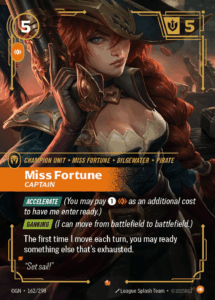
You can also move multiple units at the same time to a location, even if they originated from different locations. For example, a Yasuo – Remorseful from your base and a Kayne – Unleashed from one battlefield may both move to a second battlefield simultaneously, given both are awake and able to move there.
Moving units to a battlefield starts a Showdown, whether or not any enemy units are there. If there are no enemy units on the battlefield and at least one of your units remains at the end of a Showdown, congratulations, the battlefield is yours. Even if there are no enemy units, players may still play Actions and Reactions to try and remove the attacking units.

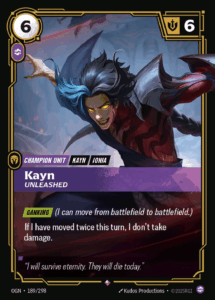
If there are enemy units on the battlefield when a Showdown begins, we have ourselves a combat. Players may still play Actions and Reactions, but after this, the units will battle each other. Let’s break down the steps of combat.
First thing when a combat Showdown starts is to determine who the attackers and defenders are. The units that move into a battlefield are the attackers, and the units that are already present are the defenders. When attacking abilities trigger and are added to the chain, and then when defending abilities trigger and are added as well.
Players then take turns playing Actions with the attacker gaining priority first. When both players pass priority without taking any actions, the combat resolves. If the attacker has units that survive and the defender doesn’t, the battlefield is conquered.
Conquering a battlefield gains you one point, and then during your next beginning phase, if you still control the battlefield you score a point. You may only score a point at each battlefield once per turn. Moving away from a battlefield and back to it with another unit the same turn will not gain you a bonus point. The first player to score 8 points wins.
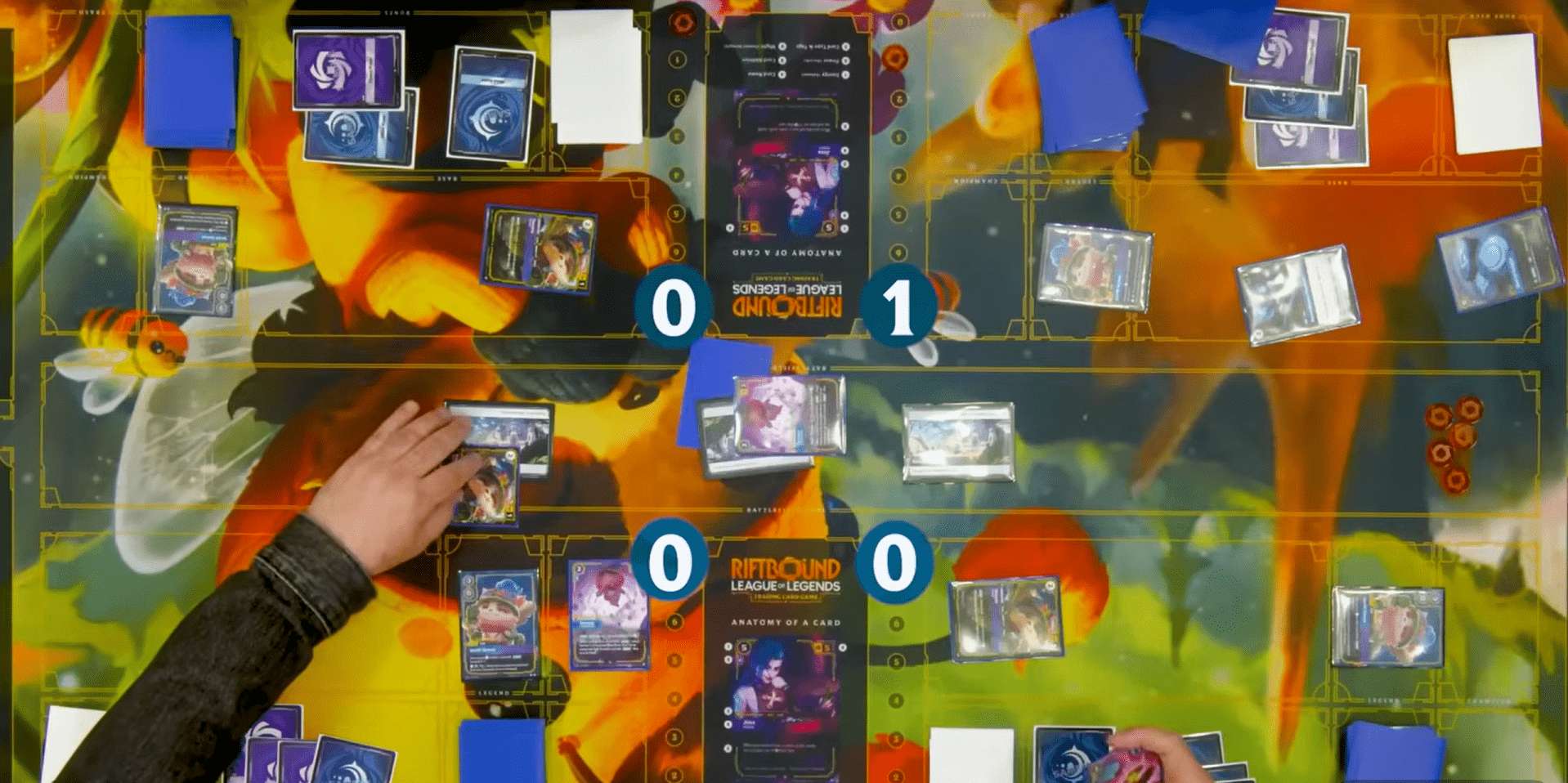
That 8th point, however, is a little more complicated than just conquering a field. Your final point must come from either holding a battlefield, or scoring each battlefield that turn. For example, if you are on 7 points and at the start of your turn you hold a battlefield, you win the game.
However, if you are on 7 points and hold no battlefields, then conquer a single battlefield, you do not win the game. You must conquer the other battlefield the same turn or hold the one you just conquered to win.
If at the start of your turn you are on 6 points and then conquer both battlefields the same turn, since you have scored a point on each battlefield that turn, you win the game. The same can be said if you start on 6, hold a battlefield to go to 7, and then conquer the second battlefield.
Notably, some cards gain you extra points, such as Ahri – Alluring. This bonus point and others like it are also able to score you your final point.
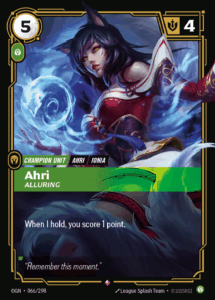
Your First Step into the Rift - Taking the Next Steps
You now have the tools to start playing Riftbound, from building a deck and understanding battlefields, to managing your runes and planning your turns. The rules are straightforward, but the strategy and gameplay has a lot of depth and nuance. Every game will teach you something new about reading your opponent, timing your moves, and using your Champion’s strengths. We are very excited to start playing Riftbound ourselves, and can’t wait to see how the game will unfold.
See you on the rift!
Read more TCG news
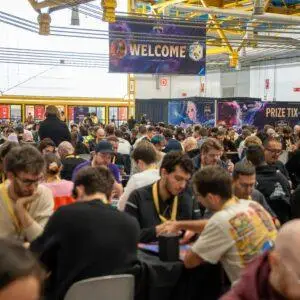
Challenges Are Back! – A Player’s Journey Through Disney Lorcana Challenge Bologna
Over 2000 Illumineers gathered under the bright lights of Bologna Fiere! See how the amazing Disney Lorcana Challenge Bologna 2025 went down.

5 Reasons You Should Be Excited for Spotlight Series Liverpool
The Magic Spotlight Series is swinging into Liverpool. Here are five reasons you won’t want to miss Magic Spotlight: Spider-Man.

A New Kind of Adventure – Pokémon Pokopia
Pokopia was announced! A first look at the recently teased Pokémon spinoff coming in 2026 is getting us excited for a cozy survival game and town builder full of creativity.


